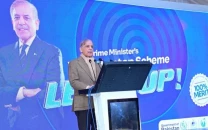How the west was lost
In the tribal areas, poverty is the largest factor leading to distress and other difficulties are enhanced by it.

Despite all the progress that has been made, the tribal areas are still poverty-stricken and much of the unsettlement can be attributed to the fact that there are too many people in the country as it is, for everyone to live in an adequate manner. The tribesmen have the alternative of remaining where they are and except in certain fertile areas, of facing great material hardships or of moving out of the tribal zone to seek employment elsewhere. The latter alternative usually implies leaving their families behind for long periods and obtaining jobs, which are frequently unsuitable and unremunerative. Some progress is being made in the implementation of plans for settling a certain number of families in the Thal development area and there is a strong possibility of similar projects being made achievable in the future, too, with the Kurram Gharri Dam being an example. In this connection, it would be important that the relevant authorities consider making a specific allocation to tribesmen out of the public lands that are promised to be reclaimed or provided with irrigation facilities. But these things can only be considered small beginnings that are needed to attack a major problem.
It must be borne in mind that poverty is the single largest factor leading to distress and that other difficulties, though not created by it, are enhanced by poverty. This means that although it is necessary to advance on a wide front — for example, material progress without comparable educational advances, particularly of a vocational type, would not be enough — the main object of a policy must be to increase the amount spent on constructive development and ensure that this development is not only rapid but also relevant to local needs.
Only by raising the standard of living will it be possible to create lasting social stability, which will prove conducive to further purposive economic enterprise. Great effort coupled with skill and tact will be required, particularly from political agents, if steady advances are to be made. Nothing positive will be accomplished in the tribal areas by external fiat and imposition from above. The tribesmen are proud of their traditional independence and no scheme, however well conceived, will prove acceptable unless the people themselves come to feel strongly the need for development and the necessity for their own cooperation in the improvement of their lives.
The schemes for the tribal belt fall into two categories: 1) schemes that are especially local in character, having been devised in conformity with the needs of the areas; 2) schemes that form part of the general programme for the expansion and improvement of agriculture, education, health services, cottage industries, etc. in the province.
The proposals in this plan constitute something more in the nature of a general policy rather than the specific allocation of large funds (apart from those set aside for particular schemes for agriculture, irrigation, etc.)
(To be concluded)
Published in The Express Tribune, November 16th, 2012.














COMMENTS
Comments are moderated and generally will be posted if they are on-topic and not abusive.
For more information, please see our Comments FAQ